Archive for August, 2021
Hilda and its Mom Problem; Spy Racers and Camp Cretaceous puts in the work
Posted by Admin in Animation, Television, Uncategorized, Writing on August 30, 2021
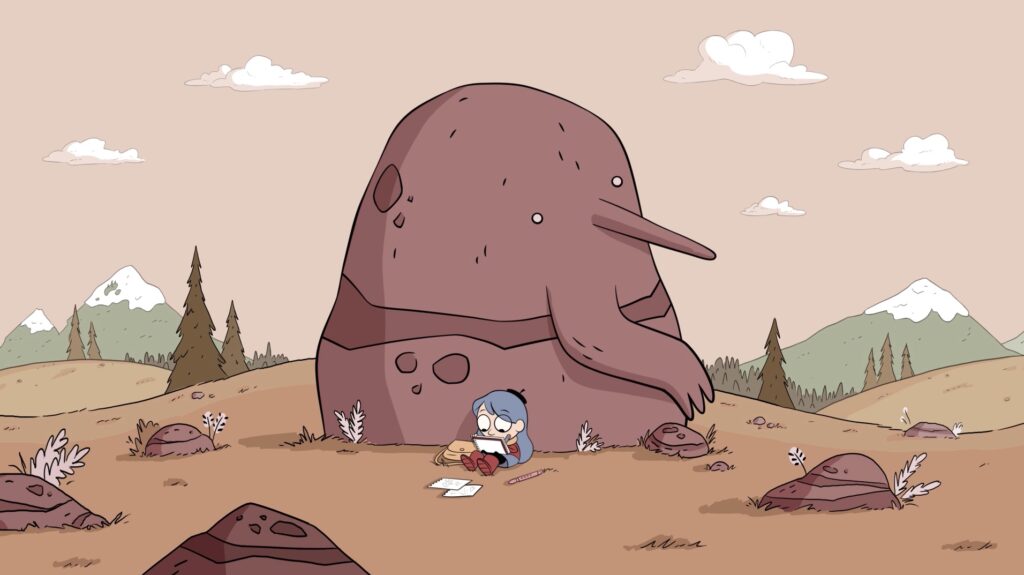
Hilda has a ton of promise as show, although it’s “third season” will be a movie instead, presumably about the fallout from the ending of the second season, which left Hilda in a body-switch scenario with a troll. It’s a pretty fraught storyline in which to end a season, especially after a season in which Hilda and her mother fought and struggled to make bonds or connections that used to come so easily to the two. They were quite the unit at the beginning of season one–the two of them living alone in a cabin in the woods, all filled with wonder and magic and near-infinite space for exploring and adventure. When they had to move to the city (their cabin was destroyed by a giant!), there was a bit of mother-daughter conflict, mostly due to Hilda’s prickly response to city-living and friend-making. But Hilda’s mom quickly showed her daughter that not only did the city possess a huge number of opportunities for adventure on its own, but that she herself knew her away around them. It was the show’s small but notable way of showcasing a strong parent-sibling bond in the face of the kind of craziness that could break them–and, by avoiding the trope of parents being unfamiliar with or ignorant of the weirdness around them, pulls its adult characters into the delightfully audacious imaginations of their children: everyone is apart of this world and has to deal with its antics equally.
So it was kind of a shock when Hilda began to exhibit alienating, and even hostile, anger at her mother throughout season two. It seemed quite a strong counter to the connection they held in season one. There’s a very specific, narrow thread to Hilda’s determined stubbornness, which can be frustrating to other people not quite attuned to it (this, in fact, causes a big blow up between her and Frieda in season one, a conflict that might require two or more watches to get.) But after watching all of season one and seeing how Hilda’s mom seemed totally on board with Hilda’s behavior, and how Hilda’s respect for her mom was so ingrained, watching her suddenly show flashes of attitude at her mom seemed so sudden and… weird. The show tried to thread this shift in Hilda’s demeanor by giving her a deep seated anxiety that had her worried that she was becoming too “naughty” with all of her antics. But it makes little sense. Season two Hilda wasn’t more or less “bad” than season one Hilda, and, again, her voracious outgoing energy has been, time and again, embraced by her mom (give or take the general concern/love/desire for safety that’s normal for any parent.)
There is, arguably, a dramatic, emotionally-rich narrative in which a young but maturing girl starts to question their status under her parent’s roof, that the hormonal and emotional changes that come with puberty and growing up might trigger confused, conflicting reactions to the rules and structure that, not long before, was accepted and tolerated. Hilda suddenly bristling at her mother’s… everything could have worked if Hilda’s encounters began to trigger new, confusing feelings within her. Maybe the moody, ghost-esque teens suddenly begin to look more appealing, or there’s a cute boy (or girl) that slowly begins to catch Hilda’s fancy. There is a potential maturation tale in which Hilda dabbles with witchcraft–although that’s mainly with Frieda, the career-defining vibe to this particular story suggests falling into an adventure-filled “job” that Hilda may want tackle sans parental helicoptering. But we never get that, not even in the narrow, nuanced ways in which Hilda usually functions (the only clue we get is a new, slightly weird post-credits song that “Hilda” sings about her struggles with her stubbornness, which kind of feels weird and desperate, a last-minute Hail Mary method to clarify Hilda’s new emotional responses since that never really happens in-show). Hilda thrives with potential, and that new struggle with her mom could have been as complex and well-handled as Steven’s post-war trauma in Steven Universe Future. But it was never meant to be; perhaps the next movie can put in the tricky, ret-con-y work to plug those daughter/mother dilemmas.
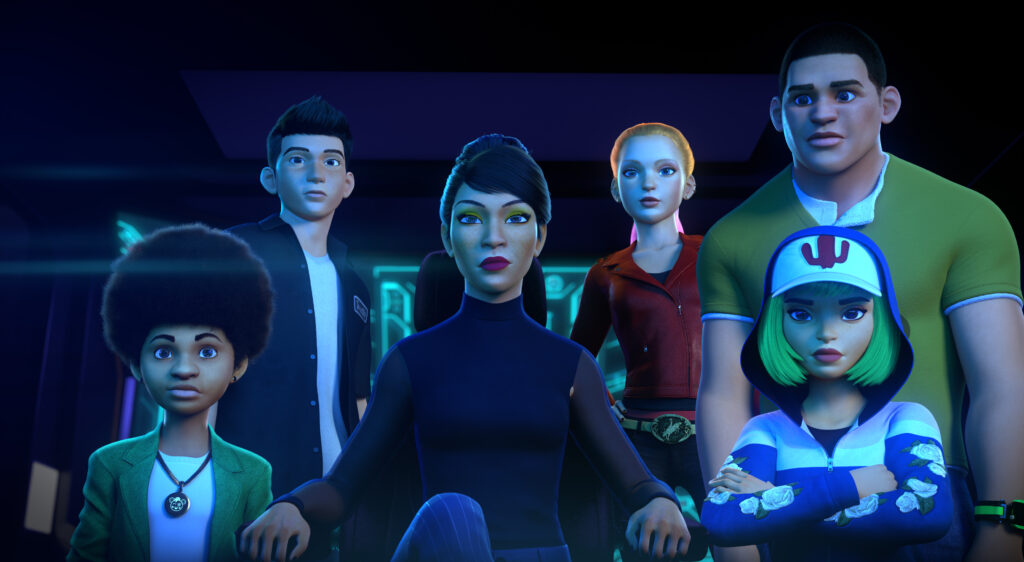
One thing I like about Fast And Furious: Spy Racers? It’s efficiency. Every season is eight ridiculous but snappy episodes that roll in, do their thing, and roll out. There’s no real commitment to the cast, theme, or story here–just fast vehicles doing crazy stunts. The jokes are dumb and forced, but everything moves at such a fast pace that nothing really sticks around long enough to be bothersome, save for a few exceptions (one second season villain, a bad parody of a Real Housewife/Instagram influencer, wears out her welcome upon returning in the third season; the Sahara season is boring because, well, racing in deserts is boring, and it drags pretty heavily).
It, and its “spiritual” counterpart, Jurassic World Camp Cretaceous, both star groups of kids in scenarios that shouldn’t star groups of kids. But both have just enough winking energy to let it roll off your shoulder. Camp Cretaceous is a lot more “grounded” than Spy Racers, in that those kids are way more defined and “realistic,” and have a much more tighter familial connection than Spy Racers hilariously throw-way “we’re family” vomit. But neither is particularly necessary; if your kids like cars and/or dinosaurs, then they’re gonna watch them. Still, shows like these are worth at least exploring once, I think, because of their efficient, workman-like approach to knocking out a season of action, drama, interpersonal conflicts, and broad, cheesy humor. At their peak, both shows can provide an episode that fires on all yeoman cylinders, a thrilling 22-minutes that almost, almost, capture that respective franchise’s best, most enjoyable moments. For Spy Racers, it’s an absurd chase between a submarine and a jet bent on destroying said sub. For Camp Cretaceous, it’s a dinosaur/kids chase within tight quarters and rickety elevators, echoing the high thrills of the OG Jurassic Park. These moments are rare and perhaps not worth wadding through so many seasons of off/on entertainment, but it shows that there’s value in shows that “do the work”.
Spy Racers thrives on bombast and nonsensical cutting edge tech, which works better than some of the stunts that the show comes up with–despite being animated, and thus able to fudge the physical possibilities of vehicular assault more than its live-action counterpart, a lot of the car action is rather bland. Because the show operates at eleven and goes from there, it’s impossible to really come up with something truly visually exciting, since… all of it is, really. And yeah, the characters are broadly drawn and too ridiculous to really engage with them. Which means that they’re perfect for everything the show is putting down. Camp Cretaceous, on the other hand, sinks its teeth into its characters, which is impressive, but arguably can go too far in this direction as well. Mining these characters for layers of nuance to otherwise create more interpersonal conflict is fine, but two characters’ choices in that show’s most recent season bordered on flat-out stupid. (Three episodes are spent dramatically hyping up one kid’s fervent desire to live on the brutal dinosaur island, only for him to obviously change his mind in an instant; one kid sudden sullen attitude towards another kid and his questionable but effective plan comes out of nowhere). Workman animated shows can be good for bumps of audio-visual sensory pleasure, but they tend to lose steam in the long run, whether trying to find more heart-pounding stunts, or scratching at the bottom of the character barrel to contrive yet another fight between characters who, by now, ought to know better. (Spy Racers just dropped its fifth season; I can’t see them going beyond seven.)
I know I said I was gonna do Looney Tunes today as well, but I’ll have to save that for later, as an emergency writing project jumped in my lap. I’m going to be away for Labor Day weekend, so I probably will tackle that show, as well as I Heart Arlo, by September 13th. I also want to discuss the… “scourge” of the generic adult animated show. (I’m a patient man who always tries to let cartoons be the way they are, but even I’ve been growing weary of the “look” of them.)
Centaurworld and The Bad Batch excel in animation but struggle with narrative
Posted by kjohnson1585 in Animation, Television, Uncategorized, Writing on August 23, 2021
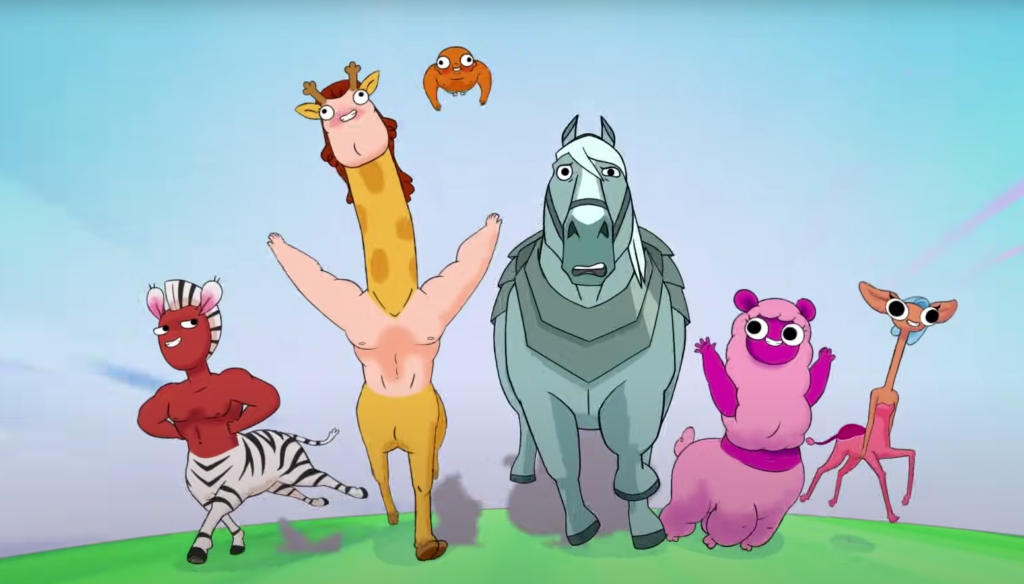
At the very least, Centaurworld is a visually rich piece of animation. In some ways, the fluidity and elastic movements of a lot of the action and expressions are better than the sharp, cinematic quality of Green Eggs and Ham, itself a fine show that probably would have worked as a movie than serialized programming. Centaurworld has a fine handle on its goofier moments, of explicit closeups and elaborate dance moves, in nifty montages and explosions of color and effects that draw the viewer eye and helps to, perhaps, ease audiences more prone to shy away from the specific and weird character designs themselves. Horse and Rider are the traditionally animated figures of the show; the centaurs of Centaurworld are what if the bubble-designs of Steven Universe would look like if forced into a Day-Glo, Laffy-Taffy machine, and it’s remarkable how the animators are able to bridge those stylistic differences so smoothly. Horse, mostly hard, sharp lines, ends up screaming and singing in silly, exaggerated, squash-and-stretch ways, and damn, it somehow works.
The story that’s told across the ten episodes of Centaurworld, however, is pretty undercooked. I started to get a bit hyped for the show when it got a bit of push on social media–a lot of talented animators, writers, and musicians worked on the show, and their words suggested something quite special. The trailers and the publicity photos also suggested something layered (if not quite new): similar to AdventureTime, the candy-coated universe of Centaurworld was something of a cover, or a mask, or a distraction, to the secondary, bookended “real” world where war thrived and lives were lost.
It’s not that. Well, not exactly. Honestly, I can’t quite put my finger on what Centaurworld is, exactly, both in the narrative/settings sense and in the broader, “what is this show even about” sense. It’s a fine show, but I found it somewhat messy and fairly… incomplete. Similar to The Owl House and Star Vs. and Amphibia and The Dragon Prince, shows with huge worlds and stringent lore and copious amounts of backstory, it all yet feels like a lot of the actual plot is being made up on the fly. There’s only two significant story reveals that occur during the course of the season, and while there are smaller flashes of dramatic narrative that pop up, they happen awkwardly and haphazardly. Centaurworld is too caught up in its “all-encompassing-ness”–in its absurd characters, its padded joke-telling, its weirdness. It has tons of confidence in its characters as entertaining weirdos being weird at each other, but they’re not exactly deep, so the premise is based whether you get a kick out of their antics. Comedy is subjective, so maybe there’s a ton of people who love these oddballs, but as avatars guiding us through this whole new world, they’re lackluster.
Kipo and the Age of Wonderbeats understood it had to clarify its new world first and foremost, to establish the rules, the boundaries, the obstacles that define it. Centaurwold doesn’t. It starts to, but then, I believe, assuming it could do the bulk of that next season, kind of just fucks around. It’s non-Horse cast contorts in weird ways and say very oddball things in very oddball ways, and they trail off or stammer around awkward moments, and they provide creepy expressions as the camera linger on them in extreme close-ups. They can “shoot miniature versions of themselves out of their hooves,” miniature versions who scream and panic because they suddenly exist and can’t handle it, a well that Rick & Morty has all but tapped dry. Centaurwold has the vibe of a Youtube poop mixed with those streaming videos cut so erratically that you can’t quite tell what the joke is, all while forgetting to clarify or develop the characters through that chaos. Horse and Ched bicker a lot, but for the life of me I couldn’t understand why they hated each other; their argument pops up in one episode randomly because, I guess, it sounded funny when they bicker? Durpleton, at one point, gains the ability to fart-verbalize validating compliments, implying that he’s never received that from his father, but the show never unpacks that (they even joke about not unpacking that) and it’s prolonged for so long with no real payoff.
There’s an episode where the characters find themselves in a world that’s a parody of Cats, in which the Cat-taurs compete to win a special sash (which also has a McGuffin they need). Zulius, the showy, stereotypically flamboyant of the group, has history with this competition (he constantly loses it), falling into exaggerated, depressed tantrums before attempting to coach Horse through it. This is pushed as important, revealing backstory (again, they make a meta joke about this) but it never answers the most obvious question: how and why did Zulius, who’s not a Cat-taur, even get so caught up in this very clearly cat-taur-only competition? The episode doesn’t say, and to be honest, it probably could get away with these non-deep deep reveals if the very second episode didn’t provide an extremely, genuinely fraught history with Wammawink. That narrative set up expectations for more fraught or informative reveals in future episodes, but none of them occur.
Centaurworld is ultimately a Weird Cartoon masking as a layered, Steven Universe/AdventureTime one, with the violent backstories, mythical architecture, mysterious characters, and unique iconography never truly being explored. (There’s an implication that the Nowhere King, the show’s Big Bad, and the nameless purple-haired human had a similar bond like Rider and Horse, a bond that in some way caused much of the chaos happening now, but in no way is that explained). The extremely dark narrative of a whale shaman ending the existence of travelers deep in depression is ruined by an obvious sign that literally explains this that somehow everyone missed. It’s the kind of bit that in a lot of ways sums up Centaurworld. Here’s hoping there’s richer, deeper rewards in the second season.

The Bad Batch, on the other hand, probably would have worked better with a lean ten or twelve episodes. It’s an excellent exploration of the aftermath of Order 66, the trigger that called forth the clones to kill all the Jedi in their vicinity. It’s a fascinating, overlooked part of the Star Wars saga, and it’s great to have a in-depth, close look at that transition from Republic to Empire. It does this by focusing on the Bad Batch, a group of clones immune to Order 66 (kind of) and action-heavy stars of average-at-best arc on The Clone Wars.
It was, at the time, odd to see the follow-up to The Clone Wars focus on this team of semi-superpowered clones. (Really, it’s the follow-up to Star Wars Resistance, a show so bad that it’s likely we’ll never see cameos from any of that show’s cast pop up elsewhere.) The Bad Batch, too, is an animated, visual tour-de-force; if the hard-edged, plasticky character models aren’t in the frame, you would swear you were watching live-action. Trees and mountains look lush and full; water effects and weather patterns are massive and dynamic, and explosions and debris damn near burst from the screen. The Bad Batch even ups its visuals by playing around with film trickery, with flashes of focus shifts and whip-pans. The score, too, is rich, bold, and loud: even without surround sound or a subwoofer, you can feel the throbbing bass in your living room or within your headphones.
But again, sixteen episodes is a lot, and like Dave Filoni’s other animated shows, it often struggles to pad out enough material to fill it. Newbie clone (of sorts) Omega, her with the sharp Kiwi accent and the precocious energy, isn’t as much as a distraction as one might suspect: she’s sharp on her toes and rather resourceful, but not so much so that she can escape every scrape that absolutely would require a trained soldier. The Bad Batch mostly struggles through prolonged filler episodes of bounty hunting for Cid (long after they financially escaped her leash) and Filoni’s overwrought penchant to bring in cameos galore (Hera, Saw, Cad Bane, [lady from Mandalorian]. None of the episodes are in any way bad, but seeing this group of mercenary soldiers talk around the same points over and over gets a bit tedious. Dee Bradley Baker voicing five different clones so distinctly and credibly is some kind of miracle; only if the writers could push those characters individually on paper a little harder, The Bad Batch could spend more time developing them specifically instead of broad, stylistic, skill-based ways. What makes them really tick? I hope we get that sooner instead of, like, the six or so episodes before the show’s series finale, like Star Wars Rebels.
Next week I might spill a few words about the silly, rip-roaring The Fast and The Furious: Spy Racers, and allow me to gush about why, finally, they finally figured out Looney Tunes. If I have time/space, I may also shed a few words about some past past animated shows I’ve caught: Hilda, perhaps?
Jellystone has the stones; The Owl House still struggles to come home to roost
Posted by kjohnson1585 in Animation, Television, Uncategorized, Writing on August 13, 2021
(I’m still trying to figure out how to make titles work for these pieces.)
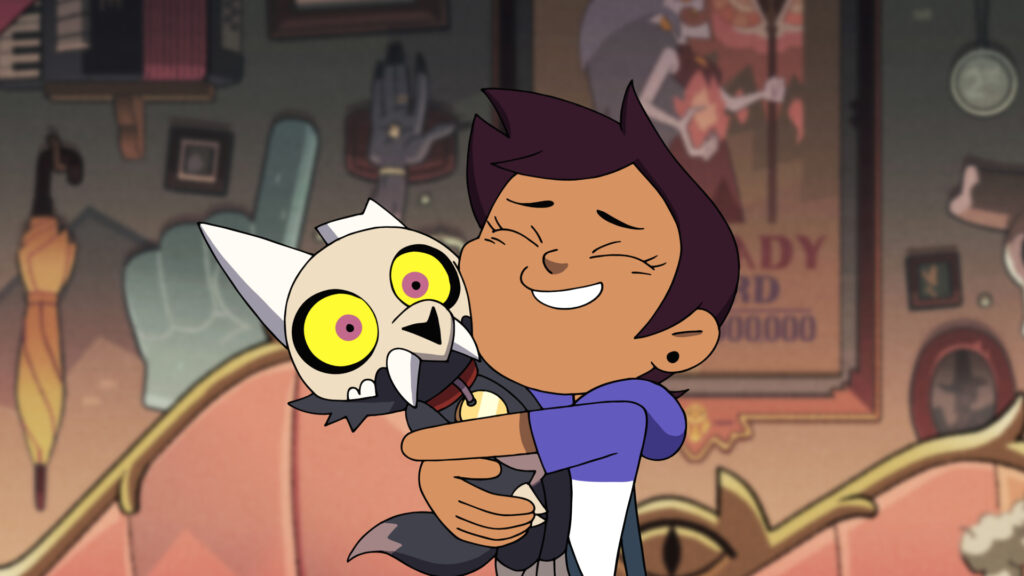
So I have a question about The Owl House. Was there an episode that, straight up, explained what the main nine witch covens actually are? I did some down-and-dirty research, and a wiki pointed out that the nine were mentioned in an episode call “Covention”. I re-watched “Covention”. They did not mention all nine covens. They mentioned one of the nine covens was “Construction,” which is structured around gaining magical strength, which is also an important plot point of the episode, but I don’t think the gaining of magical stretch is ever brought up again in the entire show. Which is weird, especially towards the end of season one where the magical fights escalate in stakes; no one bothers to use power-gaining to escalate in strength.
When The Owl House was first announced, I was quite looking forward to watching it. It had a really cool, nutty locale and the characters seemed fun and appealing. And don’t get me wrong, The Owl House is quite a fun show, but it also feels… well, perhaps not troubled, but restrained? Unsure of itself? There’s a pretty controversial piece of news about the show (which is subject to change I suppose): after this current second season, The Owl House will have one final third season, consisting of three episodes at about an hour and a half each. Even if you think Disney hates the show (which I don’t think they do, and in the next paragraph I’ll elaborate), this kind of decision is weird and unprecedented. It has the flavors of Netflix’s recent push to end some of its animated shows with movies instead of final seasons (Trollhunters, Hilda), but you can chalk that up to Netflix’s push for more affordable, quick content for weekly, new releases than whole-ass seasons. (They sort of did this with Unbreakable Kimmy Schmidt, and not for nothing, but Arlo The Alligator Boy, a fine movie as is, probably would have worked better across ten episodes.)
I think there’s a lot going on with Disney, partially in relation to Disney+. I suspect, spitballing here, that the mandate to find “the next Gravity Falls” got usurped by the push for Disney+ content, and the pandemic sort of solidified that “Disney+ at all costs” notion. A lot of Twitter seem to think its due to a same-sex dating subplot (and I can’t dismiss that out of hand, as many shows have gotten royally screwed when same-sex narratives pop up), but my inclination is that the ratings, business realities, and poor timing left The Owl House on the chopping block. (I have a theory. If the most social media appeal of your show is a “ship,” your show actually on pretty shaky ground.)
The reason I asked about the nine covens at the beginning of this piece is because I feel like knowing what the nine covens are, and who leads them, and how, specifically, they work within the society of the Boiling Isles, would be pretty important to Luz, and The Owl House as a whole. I get that the show is structured from Luz’s point of view, but as an aspiring witch, knowing what those covens are should be a day one question from her (and I get that she’s not supposed to be a great student but still). This ought to be a pretty clear point that show reveals, to flavor the world better, but to also provide the audience some kind of through-line of the world itself. In “Eda’s Requiem,” we finally see the Bard Coven in action, way late in season two. That seems really late, too me.
(I’ve written before about Anne’s weird season one lack of desire to understand the world of Amphibia, and I feel like Luz and The Owl House come from the same place: an incomplete, unfinished understanding of the world each show has created. Same for Star Vs. The Forces of Evil. Something about the way these shows deal with magic is wild if you think about it. It’s simultaneously overly complex and weirdly simple. What makes those nine covens the main ones versus the others? When Star decided to “end all magic,” why was there so little pushback? I wrote about how strange it is that a telethapy-esque spell took several episodes to set up in The Dragon Prince. Magic used to be portrayed in clear, simple terms (point fingers or wands, say some nonsense, strain oneself a bit, flashing lights!). Sometimes you had to find objects or talismans or horcruxes or runes or “places imbued with special powers”. There’s so much going on with magic in these shows now that it’s bordering on distracting; I feel more and more like I have to understand the depth of these spells to understand the depth of these characters nowadays. I partially have the same feeling for Centaurworld, which I will tackle next week.)
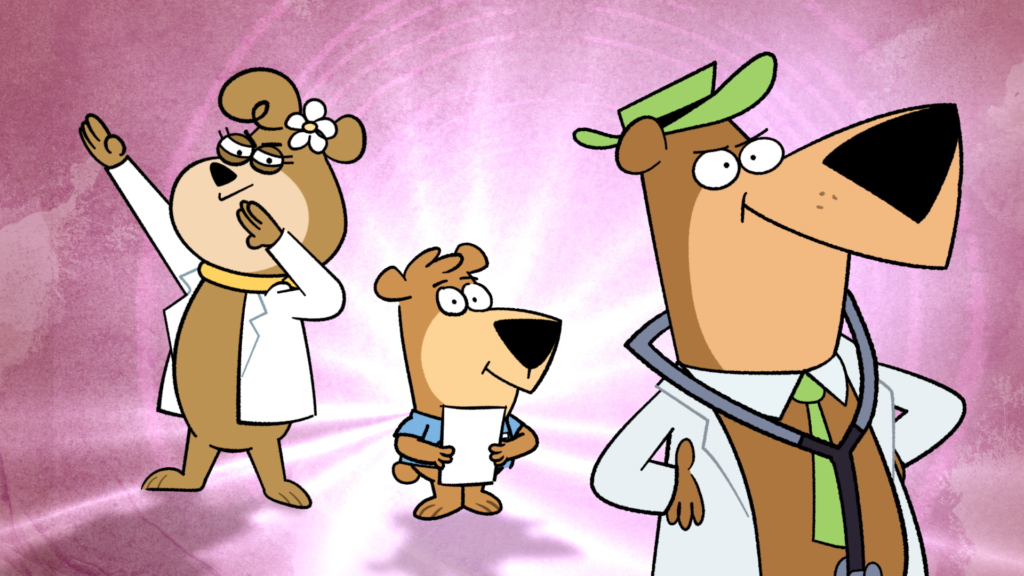
Jellystone, otherwise, is fantastic, and it helps that C. H. Greenblatt is an extremely talented creator, and that the back roster of the sillier Hanna-Barbera cartoons are sketched so thinly that all the new, updated creative choices for these characters work so well. I had my doubts that making Yogi, Cindy, and Boo-Boo doctors/nurses was a good idea, but the core nature of these characters never changed: Yogi is still darkly gluttonous, Boo-Boo is reluctantly submissive, and Cindy… well, Cindy was more the straight-bear of reason; here, she can go toe-to-toe with Yogi on the absurd escalation scale. Greenblatt needed to situation these characters in occupations or locales to give them a broad purpose; the medical field is probably the simplest to utilize, since policing is persona non grata right now, and being a lawyer is probably to complicated to work with in a kids’ show (also its connection to policing).
Many people tend to say Jellystone has a lot of Chowder-type humor, Greenblatt’s first show, but I don’t think that’s true. The two shows have aesthetic similarities for sure, but Chowder was a bit more surreal, I think, and as much as I love that show, you can kind of tell by late in its run it was losing a bit of steam. The world of Chowder was well-drawn but rather limited: you can only do so much with a not-bright, gluttonous kid and his self-absorbed mentor, with an assortment of other weirdo characters to pad things out. Jellystone has a much richer world and character-base to pull from–Hanna-Barbara’s library is rich and varied, and Jellystone has only light touched what it can do with it. Greenblatt and his creative team can make some serious comic moves here (I already thought of two whole potential specs).
More well-known characters like Wally Gator and Snagglepuss, while present, are mere side characters to Jellystone’s heavy hitters like Shag, Augie/Daddy Doggy, and Captain Caveman, who you’d think would have been placed along side the more human characters (more or less used as random shopkeepers and store employees). Loopy gets some choice lines, and I don’t even remember her (well, his) older cartoons ever airing! Top Cat and his crew make splashes, and even the Banana Splits pop up as heavy hitters. Jellystone knows that it has some freedom to re-tool a batch of characters that didn’t exactly hold up well (in the fact that probably seventy percent of these Hanna-Barbera characters have been forgotten by most people). So just the idea that we could see some deep cut characters pop up and steal the show already provides Greenblatt with swaths of material that he lacked in both Chowder and Harvey Beaks.
I’ll probably dabble with the end of The Bad Batch next week, along with a few words about Centaurworld, because I have some stuff to say about that show.

